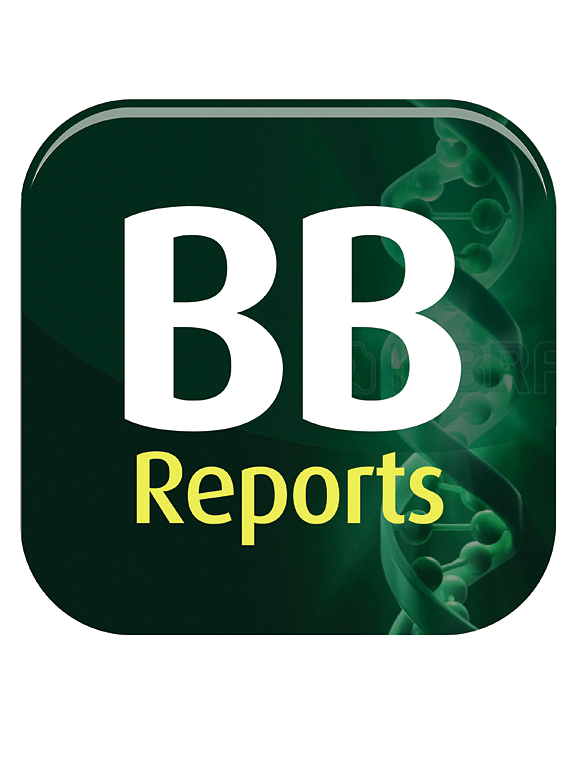Heterohybridomas producing human immunoglobulin light chains using CD138-selected bone marrow cells
IF 2.3
Q3 BIOCHEMISTRY & MOLECULAR BIOLOGY
引用次数: 0
Abstract
Background
Light chain research is hampered by lack of mammalian cell lines producing human light chains (FLC). Therefore, we used heterohybridoma (HH) technology to produce clones making FLC thereby providing tools to study light chain behavior.
Methods
Marrow CD138+ cells from patients with multiple myeloma (MM) and polyclonal gammopathy (PG) were selected, fused with B5-6 T cells and cultured in hypoxanthine-aminopterin-thymidine medium (HAT). HH clones were selected based on ELISA for human immunoglobulins and flow cytometry for intracellular (IC) FLC. We compared marrow cell counts and HH yields by diagnosis, evaluated clones making only FLC by flow and by dimer/monomer (D/M) ratios in vitro and in vivo, and sequenced FLC genes with RT-PCR.
Results
Marrows from 13 patients with active disease, 10 MM and 3 PG, were no different in mononuclear or CD138-selected cell counts. HH FLC clones (7 λ, 1 κ) were obtained from 5/10 MM and 2/3 PG; one PG case produced 2 HH FLC clones (one λ and one κ). Of the 10 MM cases, 8 had high risk cytogenetic features and 4 of the 8 produced HH clones while of the 3 PG cases 2 had negative cytogenetics and 1 had loss of IgH identified and produced an HH clone. Mononuclear (MNC) and CD138-selected cell numbers were markedly higher in the samples that enabled productive fusions. Median MFI for the 8 HH clones by IC flow for FLC was 9849 (range, 5344–27451) and median percentage of cells IC positive was 88 % (69–95). Medians of in vitro and in vivo FLC production were 47 μg/mL (9–80) per million cells after 2 days of culture and 66.4 μg/mL (16–1100) in NOD-SCID γ (NSG) mice 14 days after intraperitoneal (IP) implants of 2 × 106 HH cells. Dimer/monomer ratio medians were 0.575 (0.08–0.939) in vitro and 0.91 (0.82–2.7) in vivo, values that were correlated (R2 = 0.565) by two-tailed paired t-test with P < 0.05.
Conclusions
B5-6 T HH producing human FLC were obtained from 50 % of MM and PG cases. High numbers of MNC and CD138+ cells enabled productive fusions. The HH clones produced FLC with easily appreciated dimers and monomers in vitro and in vivo. With IP in vivo implants after 2 weeks more dimers were seen than in short term cultures in vitro. These HH clones will be made available for study of FLC metabolism and testing of therapeutics designed to abrogate FLC production or enable FLC clearance in vivo.
利用cd138选择的骨髓细胞产生人免疫球蛋白轻链的异杂交瘤
由于缺乏能够产生人轻链(FLC)的哺乳动物细胞系,轻链研究受到了阻碍。因此,我们利用异杂交瘤(HH)技术产生FLC克隆,从而为研究轻链行为提供工具。方法选择多发性骨髓瘤(MM)和多克隆伽玛病(PG)患者的smarrow CD138+细胞,与B5-6 T细胞融合,在次黄嘌呤-氨基蝶呤-胸腺嘧啶培养基(HAT)中培养。HH克隆采用ELISA法检测人免疫球蛋白,流式细胞术检测细胞内FLC。我们通过诊断比较了骨髓细胞计数和HH产量,通过流量和体外和体内二聚体/单体(D/M)比率评估了仅产生FLC的克隆,并使用RT-PCR对FLC基因进行了测序。结果来自13例活动性疾病患者(10例MM和3例PG)的细胞系在单核细胞计数或cd138选择细胞计数方面无差异。从5/10 MM和2/3 PG中获得HH FLC克隆(7 λ, 1 κ);1个PG病例产生2个HH FLC克隆(1个λ和1个κ)。在10例MM病例中,8例具有高危细胞遗传学特征,8例中有4例产生HH克隆,而在3例PG病例中,2例细胞遗传学阴性,1例IgH缺失并产生HH克隆。单核细胞(MNC)和cd138选择的细胞数量在能够产生融合的样品中显着增加。8个HH克隆的FLC的IC流中位MFI为9849(范围5344-27451),IC阳性细胞的中位百分比为88%(69 - 95%)。体外和体内FLC生成的中位数在培养2天后为47 μg/mL(9-80) /百万细胞,在NOD-SCID γ (NSG)小鼠腹腔内(IP)植入2 × 106 HH细胞后14天为66.4 μg/mL(16-1100)。二聚体/单体比中位数分别为0.575(0.08 ~ 0.939)和0.91(0.82 ~ 2.7),经P <双尾配对t检验,其相关系数R2 = 0.565;0.05.结论50%的MM和PG患者可获得sb5 -6 - T HH生成FLC。大量的MNC和CD138+细胞能够实现高效融合。HH克隆在体外和体内产生的FLC具有易于鉴定的二聚体和单体。与短期体外培养相比,在体内植入IP 2周后观察到更多的二聚体。这些HH克隆将用于FLC代谢的研究和旨在消除FLC产生或使FLC在体内清除的治疗方法的测试。
本文章由计算机程序翻译,如有差异,请以英文原文为准。
求助全文
约1分钟内获得全文
求助全文
来源期刊

Biochemistry and Biophysics Reports
Biochemistry, Genetics and Molecular Biology-Biophysics
CiteScore
4.60
自引率
0.00%
发文量
191
审稿时长
59 days
期刊介绍:
Open access, online only, peer-reviewed international journal in the Life Sciences, established in 2014 Biochemistry and Biophysics Reports (BB Reports) publishes original research in all aspects of Biochemistry, Biophysics and related areas like Molecular and Cell Biology. BB Reports welcomes solid though more preliminary, descriptive and small scale results if they have the potential to stimulate and/or contribute to future research, leading to new insights or hypothesis. Primary criteria for acceptance is that the work is original, scientifically and technically sound and provides valuable knowledge to life sciences research. We strongly believe all results deserve to be published and documented for the advancement of science. BB Reports specifically appreciates receiving reports on: Negative results, Replication studies, Reanalysis of previous datasets.
 求助内容:
求助内容: 应助结果提醒方式:
应助结果提醒方式:


